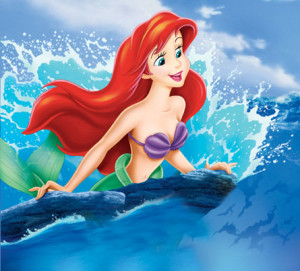Once the snow has melted, and mud dries up enough so wearing flip flops is possible, the season of dress code violations begins. Whether your school dress code policy is ultra conservative or lassiez faire, every spring, there will be one or two students, usually female, who will challenge the dress code with a startling vigor.
Part of the problem is that middle and high school females come in all shapes and sizes. A tank top may be perfectly acceptable on one boyish girl’s figure, but eye-popping on a more buxom girl. A short skirt that looks sporty on one girl can look like taut athletic bandage wrap on another. Showing a little skin, say an upper arm or a long leg may look healthy on one student while baring a large middle abdominal area or the top of the derriere provides more information than necessary.
I have often wondered how any student could think that the off the shoulder or midriff display is acceptable in school. Lately, I have been assigning the blame to Disney. Specifically, I blame the Disney princesses.
Consider how the Disney princesses of older generations were fully clothed. These princesses were:
-Snow White (1937)
-Sleeping Beauty (1959)
-Cinderella (1950)
These old-fashioned Disney princesses twirled with full skirted gowns, short or full sleeves, and accessorized their looks with gloves, capes, and the occasional scarf for cleaning. There was an open neckline, but no décolletage. Princess Aurora (Sleeping Beauty) had a slight “over the shoulder” design that was covered by a large white collar in the pink/blue/pink/blue ballgown. The only character to reveal much flesh was Peter Pan’s Tinkerbell (1953) in a strapless gymnastic tight of sparkling citrus green. In subsequent generations, and without the benefit of a singing voice, Tinkerbell has been upgraded from fairy to princess. Her more melodious princess cousins were more modest dressers.
The next round of Disney princesses began in 1989. These princesses looked and acted very differently beginning with:
-The Little Mermaid (1989)
-Beauty and the Beast (1991)
-Aladdin (1992)
-Pocahontas (1995)
-The Hunchback of Notre Dame (1996)
-Hercules (1997)
-The Frog Princess (2009)
Recall the fashion influences of each of these princesses on students for the past 24 years:
-The Little Mermaid‘s Princess Ariel’s species (born mermaid/part-time human) dictated that she wore little clothing, but the clamshells and low cut waist on her tail left little to the imagination. In creating such a daring outfit, the irony of Ariel’s lyrics,”Bet’cha on land they understand/That they don’t reprimand their daughters” appears to have been lost on her costume designers.
she wore little clothing, but the clamshells and low cut waist on her tail left little to the imagination. In creating such a daring outfit, the irony of Ariel’s lyrics,”Bet’cha on land they understand/That they don’t reprimand their daughters” appears to have been lost on her costume designers.
-Beauty and the Beast‘s Princess Belle was a throwback to the princesses of the previous generation with the exception of her bare shoulders and a plunging neckline, a daring choice for dancing with a (possibly hungry?) “Beast”.
-Aladdin‘s Princess Jasmine drew from the Ariel model; her cropped top and low cut balloon pants left a large expanse of middle, a surprising choice for a princess from a culture that suggests head to toe coverage for females in public.
-In Pocahontas, the athletic Princess Pocahontas was designed as an American-Tarzan-ette. Dressed organically in a one-shoulder playsuit of buckskin and shells, she was lean, muscular, and barefoot; there was little clothing to hamper her progress through Colonial Virginia’s brush and briar.
-In The Hunchback of Notre-Dame, the Gypsy Princess Esmerelda was dressed as the seductress Victor Hugo created; with her dark eyes smoldering over a daring low neckline and her shawl wrapped provocatively at her hips over a high slit skirt to jingle as she swayed.
-Princess Megera from Hercules had a body design lifted from the Barbie model with an equally impossible ratio of bust to hips size that allowed her to squeeze into her tight toga. While other princesses swayed, Megera sashayed into her hero’s life.
-In The Frog Princess, Disney removed the racial barrier in creating Tiana. An African American Princess, Tiana was dressed in a gown mashup of Belle’s flowing ball gown skirt sitting below Tinkerbell’s bodice, that is when she was not on screen as a naked frog.
The fashions of these Disney princesses (1989-2009) were generally less modest than the fashions of previous generations. Their costumes had plunging necklines, bared midriffs, and high skirts. Their outfits, however, could also indicate the kinds of princesses they were, not castle-bound beauties, but more hands-on active counterparts to their princes.
For a quarter of a century, girls have grown up with the images of Ariel, Belle, Jasmine, Megera, Esmerelda, Pocohantas, and Tiana. They have dreamed of swimming “Under the Sea” or running with the “Colors of the Wind” or dancing with teapots to “Be Our Guest”.
So what would be the outfit of choice for school boards trying to design policy for female students who have imitated the fashions of their beloved princesses since childhood? What princess outfit could pass muster?
There could be a vote for the clothing of Mulan (1998) a warrior princess who was forced to remain clothed top to bottom in order to hide her gender during warrior training and battle. Even when she returned to her role as a dutiful daughter, she was completely covered in a beautiful kimono. This choice, however, may be too much of a cultural stretch.
Finally, there could be a vote for the Princess Rapunzel from Tangled (2010) whose hair was the fashion statement. Part costume and part weapon, Rapunzel’s hair kept the audience from noticing any exposed body parts, however hair like hers could make movement through the crowded school hallways difficult.
Oh, Disney, if only you knew the consternation caused by your princess fashion designs. Maybe school boards could send your animators their dress codes so future princesses would dress accordingly. Better yet, Disney, you could stick to animating animals. We don’t mind seeing Dory (Finding Nemo) or Nala (The Lion King) naked; in fact, we like them better that way.




